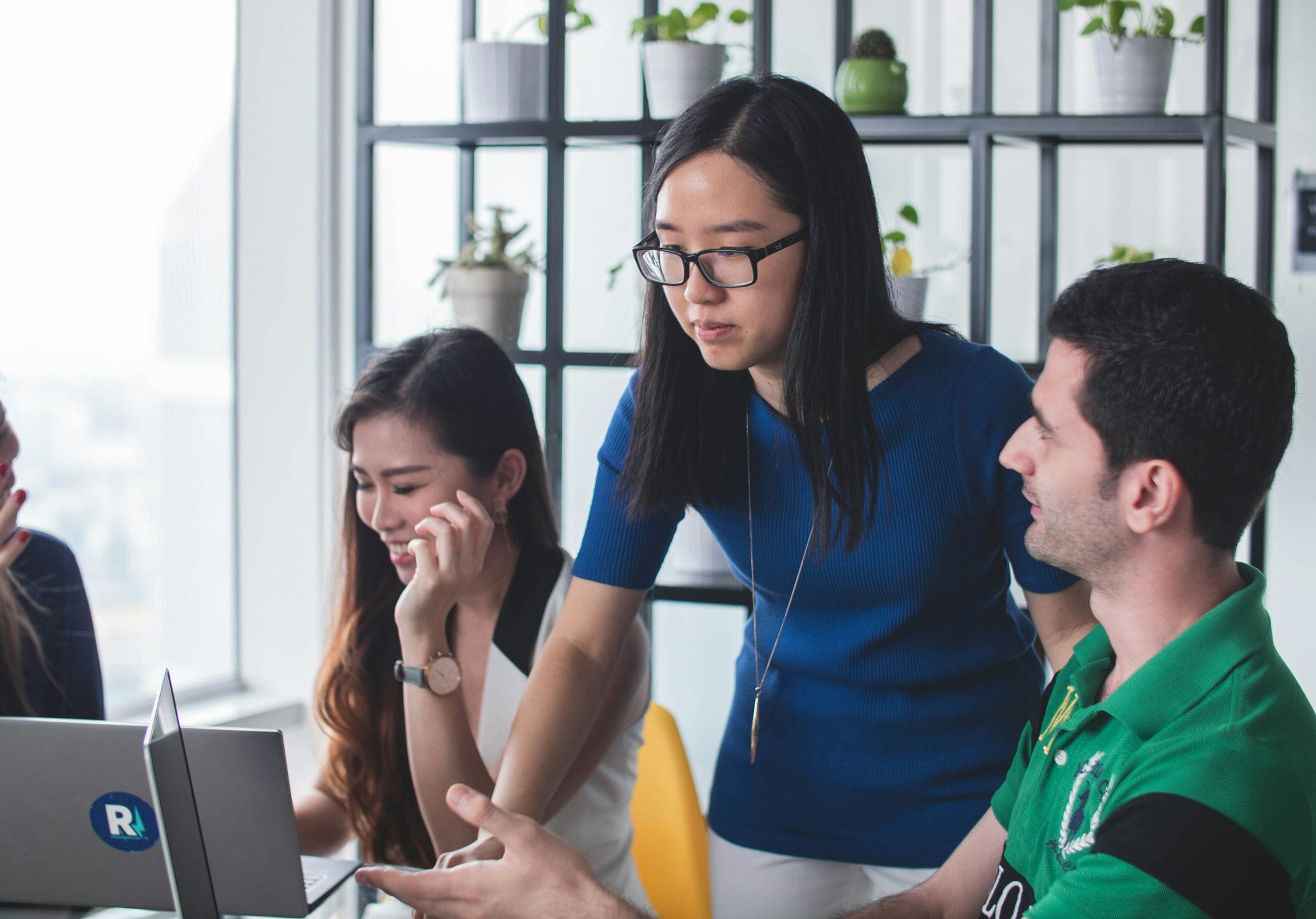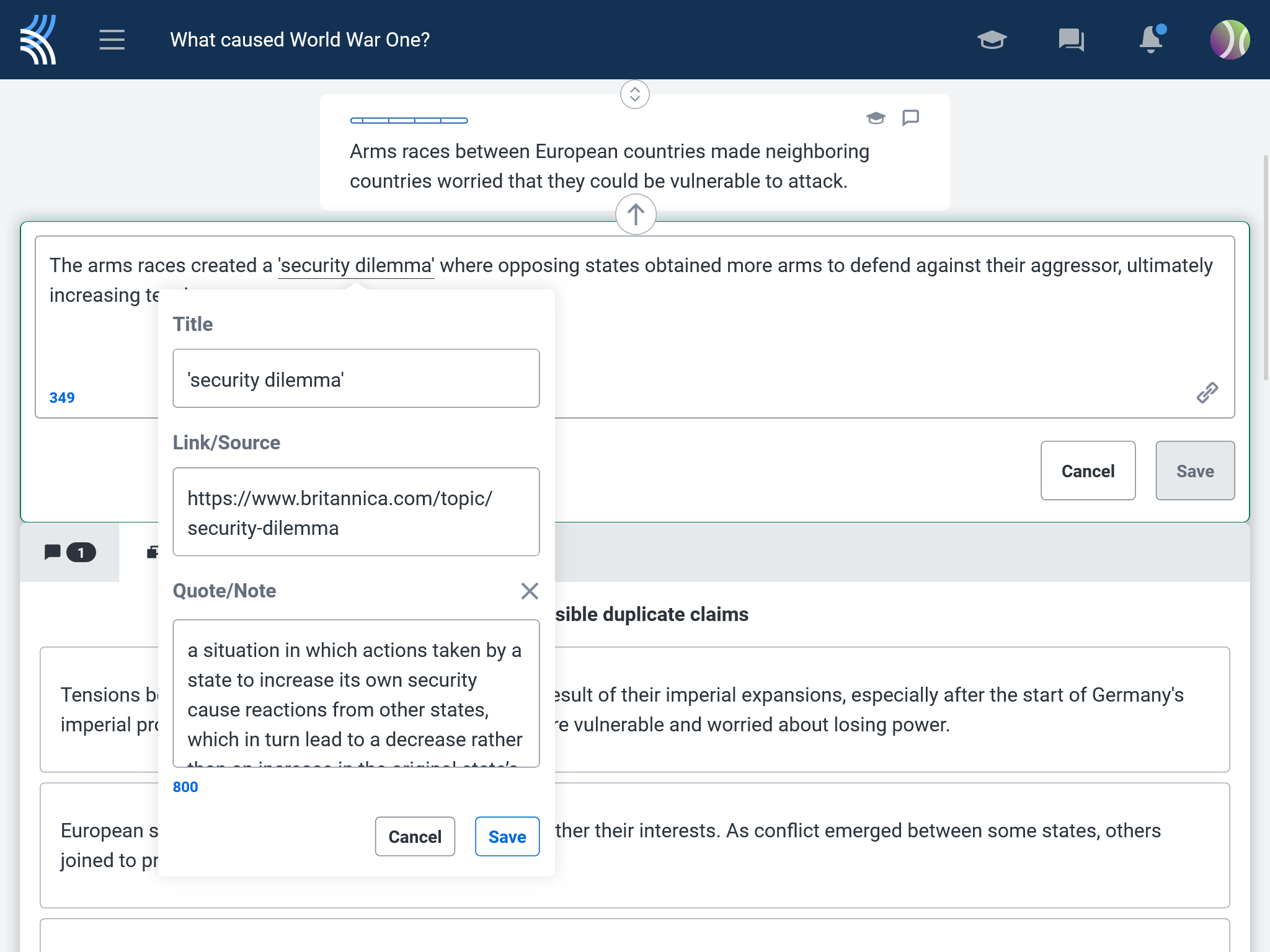History classes provide students with a peek into the human experience across times, cultures, and continents. And their relevance goes far beyond an understanding of the past! More than hitting curriculum standards, learning history shows students why we live the way we do today, helping them develop valuable historical and critical thinking skills to navigate their present and prepare them for the challenges of the future.
Let’s look at how to emphasize the importance of learning history for students and how Kialo Edu discussions can help students engage meaningfully with this subject.
Why is it important for students to learn history?
Though there are undoubtedly a lot of dates and facts in history textbooks, they only scratch the surface of what students can learn in history classrooms. Here are some of the many benefits you can give to your students next time they ask you, “Why should we learn this?”
1. Studying history gives students insight into recurring themes
From power struggles to technological advancements, students learn about the complexity of human behavior and the challenges people have faced throughout time.
2. Studying history can help students understand their own and other cultural identities
History lessons help preserve the diverse voices and experiences of individuals and communities which may otherwise be lost to time. This helps students understand their own place in the world, as well as develop consideration for others’ experiences.
3. Studying history encourages students to become informed and active citizens
By reflecting on democratic roots, values, and principles present throughout history, students can gain the knowledge to help them become active participants in society.
4. Learning history helps hone five critical thinking skills that have lifelong benefits
Finally, engaging with history gives students the opportunity to develop a broad perspective and hone their critical thinking skills. The American Historical Association outlines five of the key historical thinking skills for students to develop in the classroom, which can benefit them outside the classroom as well:
- Chronological Thinking
Chronological Thinking builds a framework for organizing historical knowledge, allowing students to understand the sequence of events and how they relate to one another across contexts and time periods.
- Historical Comprehension
Historical Comprehension is the ability to understand historical data and narratives. Students can contextualize the causes and outcomes of historical events and understand the motivations of the people involved.
- Historical Analysis and Interpretation
Historical Analysis and Interpretation is the ability to compare and contrast differing perspectives and views of history for students to come to their own conclusions and challenge common assumptions.
- Historical Research Skills
Historical Research Skills allow students to formulate meaningful questions and to gather, evaluate, and present information from a range of primary and secondary sources.
- Historical Issues: Analysis and Decision-Making
With this skill, students will be able to evaluate complex historical problems and decisions with an awareness of the ethical dimensions, priorities of those involved, and consideration of alternative approaches that may have yielded different outcomes.
Taken together, historical thinking equips students with knowledge and skills that will benefit them far beyond academic settings.
Let’s take a look at just some of the ways Kialo discussions can hit curriculum standards while making history exciting and relevant for students in the classroom!
Five engaging activities for the history classroom with Kialo Edu

1. Use Kialo discussions to connect the past to the present
Learning objective: Students will be able to evaluate the relevance of historical events and themes and explore how they might apply them to their own lives.
Looking at current events through a historical lens gives students the broader context to assess the factors that shape their world, from the backdrop to political upheaval to the formation of social movements. Not only that, but by drawing parallels between historical events and events today, students can apply the lessons learned from the past to the challenges of today.
You can assign students a Kialo discussion that explicitly links the past to the present. For example, you might ask them to reflect on questions of reparations for former colonies of European countries or to weigh up the effects of the Industrial Revolution.
A discussion on whether we should remove statues of problematic historical figures can explore contemporary views of these figures set against the era they belonged to.
Kialo discussions are a supportive space to explore topical issues in the headlines, as you can monitor and offer guidance as needed. And by adding carefully chosen starter claims to the discussion of your choice, educators can open up dedicated lines of inquiry to help students learn about the background of the issue at hand, be that geopolitical tensions or understanding responses to the COVID-19 pandemic.
2. Use Kialo discussions to question assumptions and contextualize historical narratives
Learning objective: Students will be able to compare and contrast the evidence from different perspectives on the same topic.
Without questioning the way history is presented, student understanding of the past may be incomplete or even distorted. Educators can encourage students to examine the background and perspectives of those who usually “write” history for the biases that may be present.
The argument-mapping structure of Kialo discussions can scaffold this process. By breaking down the issues into manageable chunks, discussions help highlight inconsistencies in the arguments presented for a historical topic. Have the class actively seek out gaps and contradictions in their claims to prompt wider class discussion of the potential for bias. You can even add comments or new claims to direct students’ attention where it’s needed.
Broader discussions on the historiography, or the nature of history itself, can also put these issues front and center. Have students consider the challenges historians face in finding an accurate representation of historical events by asking them “can we ever truly know history?”. Or, discuss how context shapes the lens through which we view history with a discussion on whether ethical judgments should be part of history.
3. Use Kialo discussions to deepen topic comprehension and develop critical analysis
Learning objective: Students will be able to develop historical reading skills, including sourcing, corroboration, close reading, and contextualization.
By reading and interpreting a number of texts and sources, students learn to build knowledge rather than exclusively memorize information.
Educators can help students gain a fuller view of history by giving them strategies for reading historical texts and documents. The Historical Thinking Chart by the Digital Inquiry Group (formerly the Stanford History Education Group) provides a series of questions to support students in this process.
First, have students consider the source of a document to determine its reliability. Then, students should contextualize the document by considering the broader context within which it was written. Students then look at whether they can corroborate the information by comparing it to other relevant texts, and finally do a close reading of the text, exploring the author’s claims and language choices in greater detail.
In Kialo discussions, students can aggregate all the information they encounter for a particular historical topic as evidence for their claims. This might include the different perspectives encountered, considerations of broader context, disagreement and counter-narratives, and the supporting evidence provided for these sources.
For example, if your students are exploring the causes of World War I, or considering the outcomes of the 1848 Revolutions, they can delve into these details collaboratively through the various sources available on these topics. You might start the discussion at the beginning of a module and have students return to add to their discussion as your class progresses through the materials available to them.
4. Use Kialo to explore and evaluate sources
Learning objective: Students will be able to use primary and secondary sources as evidence for their arguments.
With access to so much valuable information online, the challenge for students often lies in evaluating the evidence rather than gathering it. Many websites may seem reputable, but in reality push damaging myths or beliefs about historical events.
Educators can help students determine appropriate sources and teach strategies for “critical ignoring.” In doing so, students learn to filter out the noise and focus their critical thinking skills (and energy!) on the sources which merit their attention.

Kialo discussions encourage students to add evidence for their arguments by adding links or references to their claims where appropriate. Educators can also provide students with a selection of primary and secondary sources to work across them to come to well-reasoned (and evidenced) conclusions on the thesis.
Students could also work in groups to consider the strengths and limitations of each source, acknowledging anything that impacts their reliability in the Add Quote/Note box or comments. You can even set a task for adding sources to make expectations clear on how many students should add to each discussion.
5. Use Kialo discussions to engage younger students in the past
Learning objective: Students will be able to develop an understanding of what people’s lives were like in the past.
By learning about how people lived in the past, students gain an understanding of how the world has changed, the challenges faced back then, and how the richness of ancient cultures has influenced us today.
Kialo discussions can thus encourage younger students to think creatively about the past. They might use their imagination to fill in the gaps in known information about ancient times, with a discussion on whether they’d prefer to visit ancient Egypt or ancient Greece. You might have them reflect on what life was like during the Bronze and Iron Ages or debate whether Vikings really deserve their bad reputation!
For younger students, another engaging activity could be to determine where historical fiction meets fact in investigating the case for the existence of King Arthur. In doing so, students can gain a meaningful understanding of the past and how people lived.
Kialo’s Topic Library is full of rich history topics ready for your students to explore. If you have a thesis you think belongs in the library or any tips for the history classroom, please do get in touch at feedback@kialo-edu.com or on any of our social media channels.

